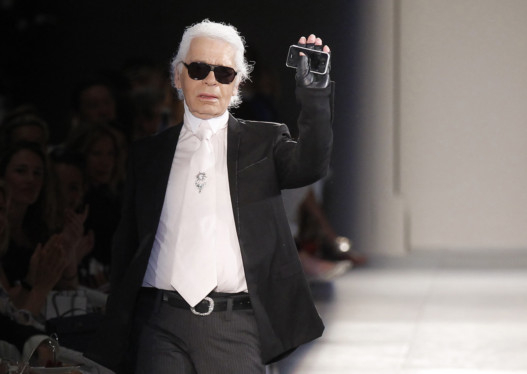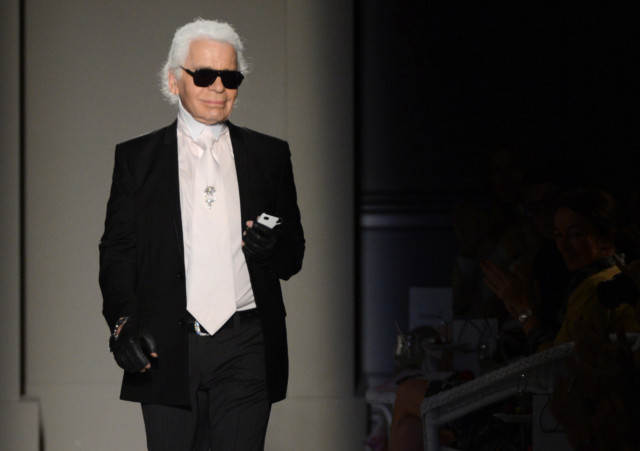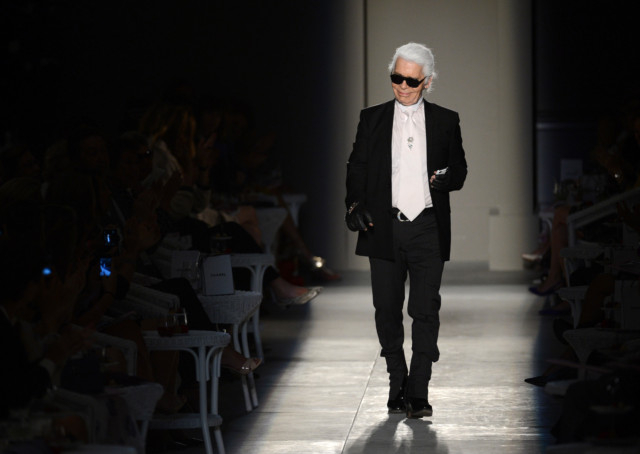
“All great fashion designers are, in the end, quite seductive. They are charismatic people,” Harold Koda, chief curator of the Costume Institute at the Metropolitan Museum of Art in New York, said to me a few months ago. That was at the launch of his exhibition about Schiaparelli and Prada, and he was talking about those two women, but the comment came back to me in Paris a fortnight ago, at the finale of the Chanel haute couture show. Supermodels were lined up shoulder-to-shoulder on the catwalk; celebrities were dotted throughout the room; and yet all eyes were on one man, a septuagenarian in a powdered wig and sunglasses.
Karl Lagerfeld is a giant of modern popular culture. “I am like a TV antenna,” he told a CNN interviewer once. “I catch everything that is in the air, and then I do it my way.” He brought Chanel, a near-moribund French label, back from the dead at a point when no one had pulled off such a feat before. That is, he didn’t just invent Chanel as we know it: he invented the whole concept of taking a brand’s heritage and converting it into something with real street value. Eight years ago, he was the very first designer to take the plunge and sell a high-street collection in his own name, at H&M, paving the way for Stella McCartney and Donatella Versace to do the same. And next time you read about a limited-edition must-have, cast your mind back to Chanel Rouge Noir nail polish, which pretty much invented that concept.
But of all the lucrative ideas Lagerfeld has dreamed up, his most important invention is himself. The persona of Karl Lagerfeld is ridiculous; deliberately so, and the closer you look, the more you get the feeling the joke is on you. (This is perhaps why Karl, each year, inches higher up the list of most popular Halloween costumes.) When he called Adele “a little bit fat” in February this year the media went into meltdown one columnist memorably commented “back off Karl, at least Adele doesn’t look like an undernourished lizard in a Pat Butcher wig” but his jibe was just the latest in a long line of insults, each finely honed to create a storm. (Yves Saint Laurent was “very provincial”, Princess Diana “was pretty and sweet, but she was stupid”.)
Over the years, the controversial soundbite has proved a very useful publicity mechanism for Lagerfeld. He sometimes tells a story about how his mother forbade him from making childish chitchat, telling him: “You may be six years old, but I am not.” From this, it seems, he learned that it can be more important to be compelling than to be nice. When you meet him in person, he is impeccably gentle, polite and well-mannered, and then occasionally he’ll just throw in something shocking. He keeps his sunglasses on for maximum inscrutability, and yet his lips twitch into a smile when he is saying something particularly outrageous.
A decade ago, Lagerfeld lost 92lb in weight, because he wanted to wear the slimline menswear of Hedi Slimane. At the same time as he shrank in physical mass, his appearance became more cartoonish: more jewellery, more leather, whiter hair. It was as if he was finessing an alter ego and what superpower could be more desirable in the modern world, after all, than dramatic weight loss?
This week, fresh from photographing Victoria Beckham for the cover of French Vogue, Lagerfeld arrived in London for a store opening. Lagerfeld is not, as we have noted, a particularly shy and retiring figure, but what is significant about this visit is that it is to publicise Karl Lagerfeld rather than Chanel. This year, the man who reinvented Coco is turning the spotlight on himself. Selfridges is opening a kind of miniature World of Karl themepark, comprising new store-in-store showcases for the Karl and Karl Lagerfeld Paris collections, and a pop-up store for Team Karl, a (you guessed it) limited-edition capsule collection of graphic T-shirts featuring his image. Lagerfeld being the grand master of the 360-degree brand experience, every element of the showcase is focused: from the clothes (lots of white shirts, leather trousers and biker jackets), the lifestyle (a huge range of cases for iPhones, iPods and iPads Lagerfeld has 20 iPads and 300 iPods) to the launch event (instead of giving a female celebrity the role, Lagerfeld is the guest of honour at his own rooftop cocktail party at Selfridges).
It is tempting to think that as Lagerfeld steps into centre stage in his own right, we will get to know what he is really like. I wouldn’t bet on it. Very little about his personal life is known for sure he claims to be 74, but some reports insist he is five years older. He paints his childhood as the heir to a German condensed-milk fortune as somewhere between Downton Abbey and Bletchley Park. Asked what he wanted for his fourth birthday, he requested a valet; as soon as learned to read, he began War and Peace. How much of any of this is true is anyone’s guess.
Several thousand public appearances later, he is still an enigma. His is a curious mix of egotistic silliness I can vouch that the butler serving his Diet Coke in a crystal goblet is not an urban myth and unexpected pragmatism. Asked about the pressures of heading up a huge brand, a sensitive topic in fashion since the John Galliano scandal, he recently told an interviewer that “in this kind of top job, you are never the victim. You may only have overestimated yourself. Stay an independent label and battle if you have such an ego problem. But don’t take other people’s money and then think you are the victim.”
Lagerfeld has reinvented Chanel’s legacy from top to bottom “respect is not creative”, he told the brand’s owners and is unapologetic in declaring “what I do, Coco would have hated.” And yet, at Chanel’s Rue Cambon headquarters in Paris, Lagerfeld’s office on the top floor is in the same room that Coco Chanel favoured. And the nameplate on the door, 41 years after Coco’s death, reads “Mademoiselle”. Which, once again, is Karl having the last laugh.















